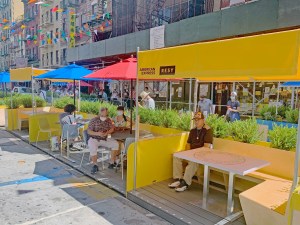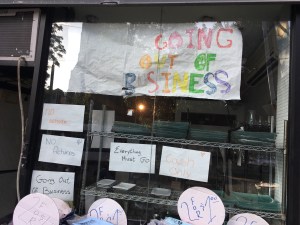Restaurants Will Soon Get More Street Space — And Maybe New York City Will Get a Permanent Improvement

New York City is about to ban cars from more streets to allow restaurants serve customers, a game-changing streetscape improvement that could have lasting implications if residents demand that livable, safe streets become a permanent fixture.
On Friday, Mayor de Blasio and Department of Transportation Commissioner Polly Trottenberg said that 40 new streets would be closed to cars by July 17 in order to allow restaurants to use the roadbed to serve customers in a socially responsible manner. That plan comes on top of the existing “Open Restaurants” rules, which allowed about 5,500 restaurants [map] to serve on sidewalks and in curbside spaces adjacent to the eatery — or on the roadway itself if the restaurant happen to be located on one of the existing 40 miles of open streets that the mayor has created.

Restaurants can start applying for the broader plan on Monday, Trottenberg said. The goal, she added is to have the restaurants work collaboratively, through business improvement District or community groups.
“If you have a block that has 20 restaurants, we just thought it wouldn’t work for 20 restaurants to all be applying separately,” she said. “We need to have some sort of cohesion within a given block or restaurant area. … We would get overwhelmed if those groups of restaurants don’t come together on how they want to set up, hours, sanitation, etc.”
It didn’t take long for restaurant industry officials and consultants to see the potential of the new plan.
“Today is a great day,” said restaurant industry consultant Henry Rinehart, who has been pushing the city on the al fresco dining issue for months. “Maybe 40 new streets isn’t that much, but once this is up and going, people will see a higher calling for our streets — but they just don’t have to be dangerous places for cars. Once there are many vibrant streets built on cafe culture, expansion of this, possibly permanently, becomes inevitable. That’s what’s so exciting now.
“I really think the mayor and commissioners have done a tremendous job,” he added.

Other details released by the mayor’s office invited some disappointment. Most important, the hours of service will only be Fridays from 5-11 p.m., and Saturdays and Sundays, noon to 11 p.m. Expanded seating will last until Labor Day, the city says.
“It’s confusing, and that creates a safety hazard, plus it adds more labor for the restaurant,” said Rinehart, who wanted the open streets to remain fully open to restaurants all week.
Restaurants around the city have already taken advantage of the earlier open restaurants plan, which allowed eateries to take control of sidewalk space and also space along the curbside commonly referred to as parking spaces. One problem, however, is that many drivers are not moving their cars because of the suspension of alternate-side-of-the-street parking. But, slowly, space is freeing up.
Restaurants that are on existing open streets can take advantage of wider areas to operate during the weekend, but will have to go back to just the sidewalk and curb space (if available) during the rest of the week, City Hall said.
https://twitter.com/brooklynspoke/status/1276317258512556039?s=12
The mayor’s announcement comes as more and more neighborhoods are starting to see the benefit of opening streets for people and closing them to cars. Even in Forest Hills, whose Council Member Karen Kozlowitz has long-opposed street safety measures that would inhibit car owners, the community board is calling for Austin Street to be made into a restaurant row, the Queens Daily Eagle reported.
And Eater provided a handy list roadways that could easily be turned into streets like Manhattan’s car-free, restaurant-only Stone Street. Even the fabled “Restaurant Row” on West 46th Street is open to car traffic, but it doesn’t have to be.
“This pandemic keeps teaching us about all the ways we’ve been using our streets wrong,” said Transportation Alternatives spokesman Joe Cutrufo.





